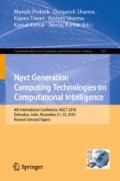Abstract
Analyzing the temporal behavior of frequent patterns and decreasing the size of discovered patterns are two major challenges in the area of temporal data mining. Several methods are available in this context, among them, constraint based pattern mining approach contributed a lot in this field. There are several methods have been proposed in this direction. However, while exploring the patterns based on time granularities: cyclic and partial cyclic patterns, the existing methods use the traditional Apriori algorithm or Interleaved algorithm, that takes lots of time while generating candidates. In this paper, a new strategy – Frequent Pattern Growth technique Incorporated with Special Constraints (FPGSC) is proposed. Here, complete cyclic and partial cyclic constraints are imposed on the framework consists of a Frequent pattern growth method for generating frequent patterns. This algorithm is able to discover complete cyclic and partial cyclic patterns in an efficient way. We also analyze the experimental results that show that it is as efficient as other algorithms in this field and it is better to generate more appropriate temporal patterns.
Access this chapter
Tax calculation will be finalised at checkout
Purchases are for personal use only
References
Upadhyay, P., Pandey, M.K., Kohli, N.: A comprehensive survey of pattern mining: challenges and opportunities. Int. J. Comput. Appl. 180(24), 32–39 (2018)
Srikant, R., Agrawal, R.: Mining sequential patterns: generalizations and performance improvements. In: Apers, P., Bouzeghoub, M., Gardarin, G. (eds.) EDBT 1996. LNCS, vol. 1057, pp. 1–17. Springer, Heidelberg (1996). https://doi.org/10.1007/BFb0014140
Chen, Y., Chiang, M., Ko, M.: Discovering time-interval sequential patterns in sequence databases. Expert Syst. Appl. 25, 343–354 (2003)
Mannila, H., Toivonen, H., Verkamo, A.: Discovery of frequent episodes in event sequences. Data Min. Knowl. Discov. 1(3), 259–289 (1997)
Lee, C., Chen, M., Lin, C.: Progressive partition miner: an efficient algorithm for mining general temporal association rules. IEEE Trans. Knowl. Data Eng. 15(4), 1004–1017 (2003)
Huang, J., Dai, B., Chen, M.: Twain: two-end association miner with precise frequent exhibition periods. ACM Trans. Knowl. Discov. Data 1(2) (2007). Article no. 8
Ozden, B., Ramaswamy, S., Silberschtaz, A.: Cyclic association rules. In: International Conference on Data Engineering, pp. 412–421 (1998)
Ramaswamy, S., Mahajan, S., Silberschatz, A.: On the discovery of interesting patterns in association rules. In: International Conference on Very Large Databases, New York, USA (1998)
Antunes, C., Bebiano, T.: Mining patterns with domain knowledge: a case study on multi-language data. In: International Conference on Information Systems, Shanghai, China, pp. 167–172 (2012)
Pina, S.M., Antunes, C.: (TD)2PaM: a constraint-based algorithm for mining temporal patterns in transactional databases. In: Correia, L., Reis, L.P., Cascalho, J. (eds.) EPIA 2013. LNCS (LNAI), vol. 8154, pp. 390–407. Springer, Heidelberg (2013). https://doi.org/10.1007/978-3-642-40669-0_34
Mitsa, T.: Temporal Data Mining. Chapman & Hall/CRC (2010)
Zhou, Q., Fikes, R.: A reusable time ontology. In: Press, A. (ed.) AAAI Workshop on Ontologies for the Semantic Web (2002)
Pei, J., et al.: Mining sequential patterns by pattern-growth: the prefixspan approach. IEEE Trans. Knowl. Data Eng. 16(10), 1424–1440 (2004)
Han, J., Pei, J., Yin, Y., Mao, R.: Mining frequent patterns without candidate generation: a frequent-pattern tree approach. Data Min. Knowl. Discov. 8(1), 53–87 (2004)
Fournier-Viger, P., Lin, J.C.: A survey of sequential pattern mining. Data Sci. Pattern Recogn. 1(1), 54–77 (2017)
Author information
Authors and Affiliations
Corresponding author
Editor information
Editors and Affiliations
Rights and permissions
Copyright information
© 2019 Springer Nature Singapore Pte Ltd.
About this paper
Cite this paper
Upadhyay, P., Kohli, N., Pandey, M.K. (2019). Discovering Cyclic and Partial Cyclic Patterns Using the FP Growth Method Incorporated with Special Constraints. In: Prateek, M., Sharma, D., Tiwari, R., Sharma, R., Kumar, K., Kumar, N. (eds) Next Generation Computing Technologies on Computational Intelligence. NGCT 2018. Communications in Computer and Information Science, vol 922. Springer, Singapore. https://doi.org/10.1007/978-981-15-1718-1_19
Download citation
DOI: https://doi.org/10.1007/978-981-15-1718-1_19
Published:
Publisher Name: Springer, Singapore
Print ISBN: 978-981-15-1717-4
Online ISBN: 978-981-15-1718-1
eBook Packages: Computer ScienceComputer Science (R0)

